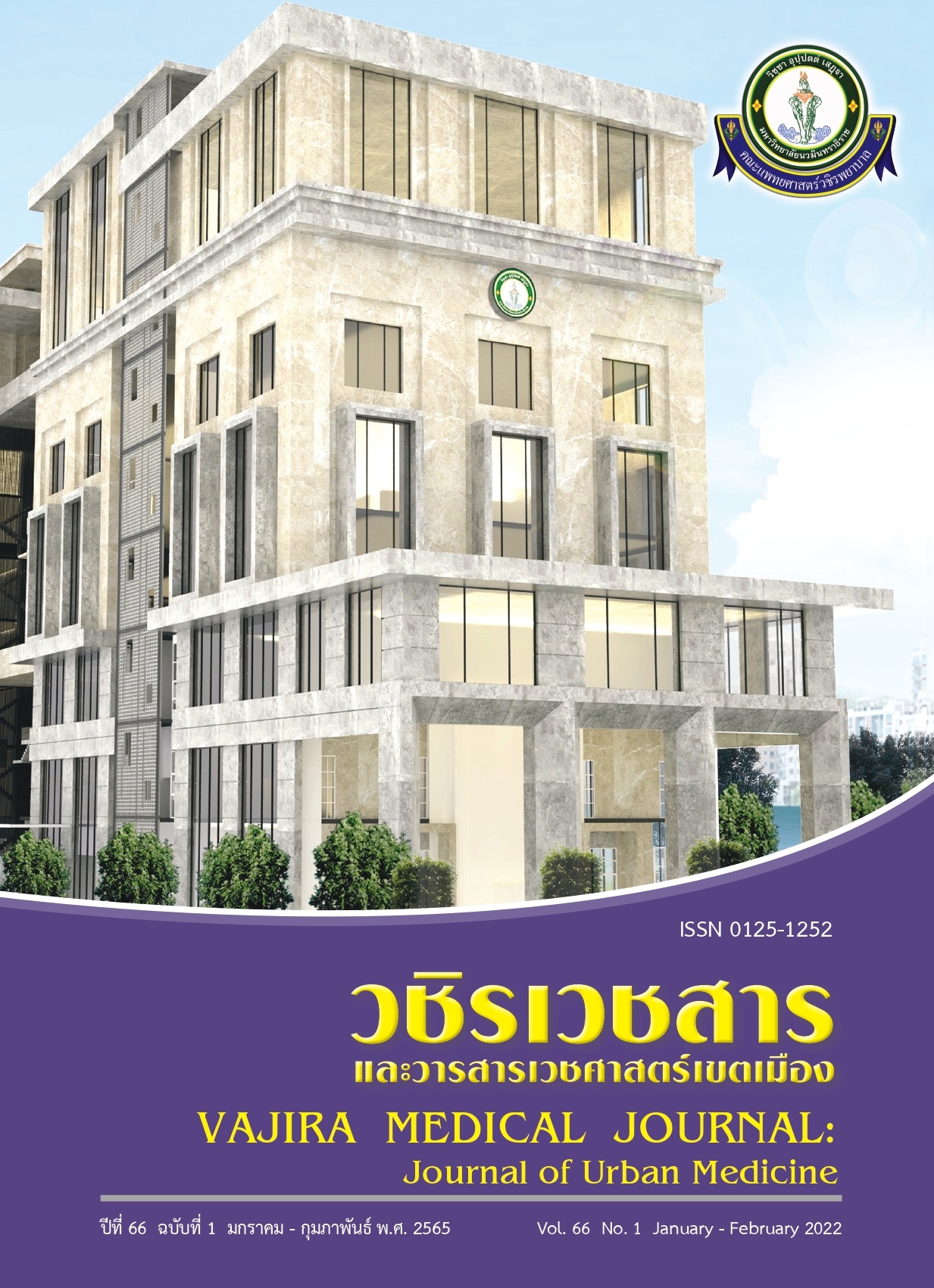Epidemiologic Study of Ventilator Associated Pneumonia in Neonatal Intensive Care Unit
Main Article Content
Abstract
Objective: To determine the bacterial pathogens and susceptibility patterns causing ventilator associated pneumonia (VAP) in neonatal intensive care unit (NICU)
Methods: Retrospective descriptive study, collected data from microbiology department and medical records of newborn diagnosed as VAP at Faculty of Medicine Vajira Hospital, Navamindradhiraj University since January 1, 2016 to October 31, 2020.
Results: Forty four of specimens from sputum were diagnosed with VAP. The major pathogens were gram negative bacteria (93.2%) which included S. maltophilia (36.4%), P. aeruginosa (34.1%), A. baumannii (9.1%), Acinetobacter spp. (6.8%), E. coli, K. pneumoniae and Klebsiella spp. (2.3% each equally). A gram positive bacterium was S. aureus 6.8% which sensitive to methicillin 100% . All S. maltophilia isolates were sensitive to ceftazidime, ciprofloxacin, imipenem and piperacillin/tazobactam. A.baumannii isolates were 100% sensitive to colistin and tigecycline, 50% sensitive to amikacin, cefoperazone/sulbactam, ceftazidime, ciprofloxacin, gentamicin, imipenem, meropenem and piperacillin/tazobactam. P. aeruginosa isolates were 100% sensitive to amikacin, cefoperazone/sulbactam, gentamicin and piperacillin/ tazobactam, 92.9% sensitive to ceftazidime and meropenem, 88.9%, 86.7% and 85.7% were sensitive to ciprofloxacin, imipenem and colistin, respectively. E. coli was ESBL 100% that all susceptible to amikacin, ceftazidime, carbapenems and piperacillin/tazobactam.
Conclusion: The bacterial pathogens causing VAP in NICU at Faculty of Medicine Vajira Hospital were S. maltophilia, P. aeruginosa, A. baumannii, Acinetobacter spp., E .coli. The empirical antibiotic of choice is piperacillin/tazobactam or ceftazidime or carbapenems. Combination with aminoglycosides or ciprofloxacin is crucial for severe case and cloxacillin for suspected S. aureus. In case of carbapenem resistant A. baumannii (CRAB) and not improve with other empirical antibiotics, consider tigecycline plus colistin.
Downloads
Article Details

This work is licensed under a Creative Commons Attribution-NonCommercial-NoDerivatives 4.0 International License.
References
Tablan OC, Anderson LJ, Besser R, Bridges C, Hajjeh R; CDC; Healthcare Infection Control Practices Advisory Committee. Guidelines for preventing health-care--associated pneumonia, 2003: recommendations of CDC and the Healthcare Infection Control Practices Advisory Committee. MMWR Recomm Rep 2004;53(RR-3):1-36.
Silva ARAD, Silva TCD, Bom GJT, Vasconcelos RMB, Junior RS. Ventilator-associated pneumonia agents in Brazilian neonatal intensive care units-a systematic review. Braz J Infect Dis 2018;22(4):338-44.
Anugulruengkitt S. Drug resistant bacteria in healthcare-associated infections. In: Jantarabenjakul W, Anugulruengkitt S, Puthanakit T, Pancharoen C, editors. Drug-resistant organisms in pediatrics: Diagnosis and treatment. Bangkok: Active Print; 2019. p.147-73.
Afjeh SA, Sabzehei MK, Karimi A, Shiva F, Shamshiri AR. Surveillance of ventilator-associated pneumonia in a neonatal intensive care unit: characteristics, risk factors, and outcome. Arch Iran Med 2012;15(9):567-71.
Cernada M, Aguar M, Brugada M, Gutiérrez A, López JL, Castell M, et al. Ventilator-associated pneumonia in newborn infants diagnosed with an invasive bronchoalveolar lavage technique: a prospective observational study. Pediatr Crit Care Med 2013;14:55-61.
Tan B, Xian-Yang X, Zhang X, Peng-Zhou X, Wang P, Xue J, et al. Epidemiology of pathogens and drug resistance of ventilator-associated pneumonia in Chinese neonatal intensive care units: a meta-analysis. Am J Infect Control 2014;42(8):902-10.
Wójkowska-Mach J, Merritt TA, BorszewskaKornacka M, Doma-ska J, Gulczy-ska E, Nowiczewski M,et al. Device-associated pneumonia of very low birth weight infants in Polish Neonatal Intensive Care Units. Adv Med Sci 2016;61:90-5.
Lee PL, Lee WT, Chen HL. Ventilator-Associated Pneumonia in Low Birth Weight Neonates at a Neonatal Intensive Care Unit: A Retrospective Observational Study. Pediatr Neonatol 2017;58:16-21.
Petdachai W. Ventilator-associated pneumonia in a newborn intensive care unit. Southeast Asian J Trop Med Public Health 2004;35(3):724-9.
Nuntiyagul T. Ventilator - Associated Pneumonia in Premature Infants in a Neonatal Intensive Care Unit at Chaoprayayommaraj Hospital: The Rates, Risk Factors and Outcomes. J Health Sci 2018;17 Suppl 3: SIII724-35.
Ounchanum P. Ventilator-associated pneumonia in a neonatal intensive care unit of Chiangraiprachanukroh Hospital. Chiang Rai Med J 2015;7(2):37-47.
Asanathong NW, Rongrungreung Y, Assanasen S, Pumsuwan V, Wiruchkul N, Lapphra K., et al. Epidemiology and trends of important pediatric healthcare-associated infections at siriraj hospital, Thailand. Southeast Asian Journal of Tropical Medicine and Public Health 2017;48(3):641-54.
Puttilerpong C, Chawanasit W, Laohawaleesan W , Rungsang W, Ritteeveraku P. Antimicrobial Use in Hospital-Acquired Pneumonia with Multidrug-Resistant Acinetobacter baumannii at King Chulalongkorn Memorial Hospital. Thai Pharm Health Sci J 2011;6:32-8.
Kaphan K, Muangcom S. Incidence rates and impact of ventilator-associated patients in pediatric intensive care unit Chiang Mai University Hospital. Chiang Mai Med J 2015;54(3):129-38.
National Antimicrobial Resistance Surveillance Center, Thailand. Current antibiotic resistant bacteria situation [Internet]. 2018 [updated 2019 April; cited 2020 July 5] Available from: http://narst.dmsc.moph.go.th/antibiograms/2018/12/Jan-Dec2018-sputum.pdf
National Antimicrobial Resistance Surveillance Center, Thailand. Antibiotic resistant situations 2000-2018 [Internet]. 2018 [updated 2019 July; cited 2020 July 5] Available from: http://narst.dmsc.moph.go.th/data/AMR%202000-2018-12M.pdf
Garner JS, Jarvis WR, Emori TG, Horan TC, Hughes JM. CDC definitions for nosocomial infections, 1988. Am J Infect Control 1988;16(3):128-40.
Niederman MS. Hospital-acquired pneumonia, health care-associated pneumonia, ventilatorassociated pneumonia, and ventilator-associated tracheobronchitis: definitions and challenges in trial design. Clin Infect Dis 2010;51 Suppl 1:S12-7.
Horan TC, Andrus M, Dudeck MA. CDC/NHSN surveillance definition of health care-associated infection and criteria for specific types of infections in the acute care setting. Am J Infect Control 2008;36(5):309-32.
Foglia E, Meier MD, Elward A. Ventilatorassociated pneumonia in neonatal and pediatric intensive care unit patients. Clin Microbiol Rev 2007;20(3):409-25.
Centers for Disease Control and Prevention. Ventilator associated pneumonia and nonventilator associated pneumonia event [Internet]. 2019 [updated 2019; cited 2019 July 5] Available from:https://www.cdc.gov/nhsn/pdfs/pscmanual/6pscvapcurrent.pdf
Centers for Disease Control and Prevention. Device-assoc iated module. Pneumonia (Ventilator associated [VAP] and non-ventilator associated [PNEU] event. [Internet]. 2019 [updated 2019; cited 2019 May 25]. Available from: https://www.cdc.gov/nhsn/pdfs/pscmanual/6pscvapcurrent.pdf
Gereige RS, Laufer PM. Pneumonia. Pediatr Rev 2013;34(10):438-56.
Alexander J. Bacterial infection. In: Kumar V, Abbas A, Fausto N, Aster J, editors. Robbins and Cotran pathologic basis of disease. 8th ed. Philadelphia Elsevier; 2010. p.357-80.
Department of Medical Sciences, Ministry of Public Health. Standard handbook of medical and public health microbiology laboratory. Bangkok: Text and Journal Publication; 2017. p.34. (in Thai)
Department of Medical Sciences, Ministry of Public Health. Standard handbook of medical and public health microbiology laboratory. Bangkok: Text and Journal Publication; 2017.p.74. (in Thai)


